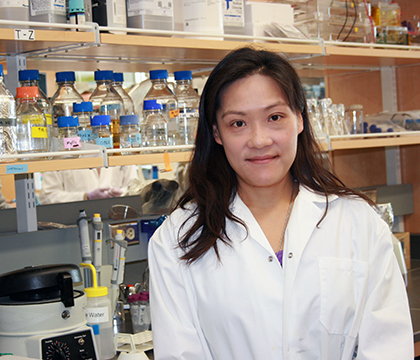
Linking behaviour with molecular structure
What does the shape of a molecule have to do with behaviour?
By U of S CommunicationsFor Adelaine Leung, forming and pursuing this question has taken her on a winding path from Ontario to Alabama, Cambridge to Boston, and finally to the U of S, where she is an assistant professor in veterinary biomedical sciences.
"I'm interested in studying the molecular structure of protein complexes that are important in the development of neural circuits that govern behaviours," she said, adding she is actively recruiting graduate students to share in this quest.
Leung completed her undergraduate and master's degrees at McMaster University in Hamilton, where she specialized in crystallography—the study of how atoms are arranged into molecules, and how these shapes determine function. She is adept at using synchrotron light for this work, and the presence of the Canadian Light Source at the U of S was a major draw.
After completing her master's, Leung moved to Alabama to work as a crystallographer looking at molecules of pharmaceutical interest at the Southern Research Institute. It was there that she was introduced to the possibilities of a career in academia, and sought a program to complete her PhD and perhaps travel in Europe.
She found it at the Medical Research Council Laboratory of Molecular Biology (MRC LMB) at Cambridge in England—a place she had never heard of. It turned out to be one of the premiere research institutes in the world, founded by crystallographer Max Perutz, one of 10 Nobel laureates from the institute.
"The first week there, I was making some stock solution and this old guy came by and asked, ‘could I borrow some five molar sodium chloride?' —and that was Max Perutz!" she said. "I was, ‘oh, yes, I have a whole litre, please take it!'"
It was at MRC LMB that she started hearing about the next big thing—neurobiology, the inner workings of the brain.
"I thought, want to do neurobiology. I want to do behaviour. I want to see if —my background is in molecular structure—is there a way to tease out molecular interactions that give rise to behaviour?"
This brought her back across the Atlantic to Harvard Medical School for postdoctoral work in behavioural genetics, using fruit flies as a model system.
Leung explained that the winding path of her career has been inspired at crucial points by professors, supervisors and senior researchers, and she hopes to be that inspiration for her students. She also urges her students to look beyond the facts they're hearing in lectures and ask how this knowledge came to be, for example through sometimes fierce debate over competing theories.
"There's a lot of drama in scientific research," she said. "I think that in traditional lectures, students only learn the facts and they miss out on the excitement, the drama."
